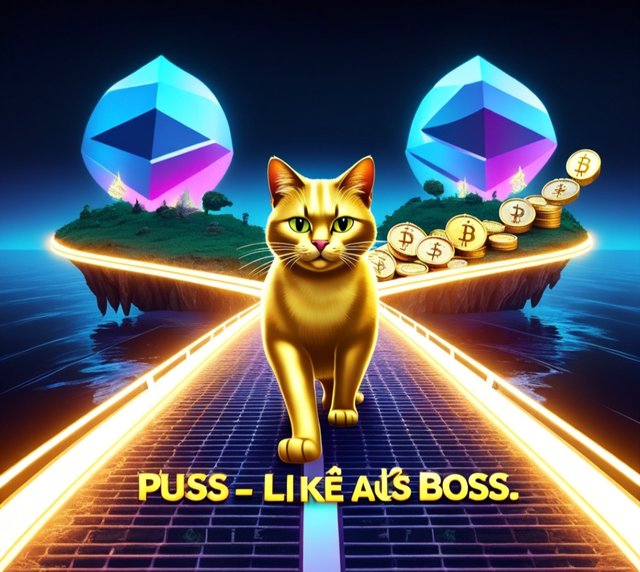$PUSS Coin's Tokenomics: Supply, Demand, And Distribution
INTRODUCTION
Well-structured tokenomics lies at the core of every successful crypto ecosystem. Drawing from this analogy, the success of PUSS Coin is entirely dependent on the application of supply, demand, and distribution mechanisms. These things are not mere numbers—they build trust amongst users, motivate participation, and determine the token's value in the real world; thereby providing a balanced and resilient financial bedrock upon which growth may be founded.
The scarcity that token supply brings to bear yields value in the long-term, while demand leads to usage and recognition in the highly competitive market. PUSS Coin must draw upon a wise balance that restricts overproduction yet provides enough liquidity for everyday operations. Controlled issuance, deflationary mechanisms, and solid utility can create attraction toward the market and develop lasting value for all holdings, developers, and future users.
The transparency in token distribution is truly important in building the community and allows decentralization of the platform. This way, the PUSS Coin can reduce token hoarding and reward early contributors to the ecosystem. Where token holders believe that everyone is fairly treated, and they too benefit from holding tokens or contributing to the ecosystem, organic growth would begin. Together, these tokenomics pillars nurture a flourishing and trusted crypto project.
- BURN MECHANISMS
Burn mechanisms cause a slow reduction in the total supply of PUSS Coin, thus increasing scarcity and, potentially, value. Since tokens can be forcibly removed from circulation if sent to an abyss address whose keys are unknown, this creates long-term demand and rewards holders by shrinking the availability of tokens without requiring active contribution.
Burns may be programmed on a schedule or be activated by certain events. For instance, burn cycles may be activated after every transaction fees received or after a month's worth of marketplace revenues have been accumulated. This aligns ecosystem activity with token scarcity: the greater the growth of the network, the greater the deflationary pressure. This adds a natural feedback loop to help sustain growth.
Transparency and clarity in burn operations are very important. Publicly viewable burn addresses and smart contracts provide open trust to the community and guarantee that the activity will be carried out as prescribed. Once users comprehend how supply manipulation is taking place, they would generally prefer to continue holding the PUSS Coin for a long time. Burn mechanisms speak of a token economy well thought through, which cares just as much for engagement of the user as for price stability.
- STAKING INCENTIVES
Staking provides an incentive for users by asking them to lock PUSS Coins in a smart contract to secure some network operation or in some DeFi protocol. And in return, they collect more tokens, thereby encouraging loyalty to the ecosystem. Staking mechanisms always tend to reduce circulating supply and build up long-term commitment by holders, which helps price stability and a thriving economy for the token.
Staking can be structured so that the incentives vary according to the amount of coins locked and/or the duration of lock-up. This way, both smaller and bigger holders would benefit. It also benefits them in governance participation since the stakers can weigh in on the ecosystem proposals, having an active voice on the direction and further development of the project.
Incentives must maintain a balance with inflation. Such high returns attract participants, but it is best if these returns do not grow faster than the ecosystem's value creation. Sustainable staking will attach rewards to network usage, network performance, or community growth so that token issuance truly follows the actual economic contribution and not speculative or extractive behaviors.
- UTILITY INTEGRATION
Utility is something that every single token has, or can really have, to stay valuable over the long term. PUSS coins can be converted and used as tools for governance, for access to premium features, or for enterprises that allow interaction with NFT or DeFi. Just by way of the implementation of such utilities, PUSS Coin is something that does matter by being implemented in the real world, rather than being a free-floating blockchain speculative asset.
Embedding utility into core services makes PUSS Coin useful in the ecosystem. On occasion, utility will involve the payment of fees on a marketplace, the subscription to a digital service, or perhaps the releasing of a benefit for the community. In turn, this generates organic demand. The more utility available, the more users have to acquire and hold the token in order to participate fully.
Utility, however, should never be static but rather be responsive to ongoing community input. Developers could agree to expand the use cases to virtual meetups, collectible exclusive content, or additional in-game assets. In this way, the token stays within an ever changing dimension of the greater digital economy while standing to jumpstart new users able to hold on to old ones.
- BUYBACK PROGRAMS FOR TOKENS
Buybacks use revenue or reserves to repurchase PUSS Coins from the open market, thus creating scarcity and building confidence in the token for the future. Price supports are placed through buybacks to reward holders who intend to keep their tokens over the long term, creating scarcity in times of market uncertainty or low liquidity.
Strategic buybacks can be subject to automation or community voting. For instance, treasury funds might be made available on a monthly basis to buy tokens according to certain fixed formulas or performance metrics. This adds to the attractiveness of its tokenomics for both institutional and retail participants by providing transparency and predictability.
Buybacks yield far better results when used alongside burns. Acquired tokens can be kept in reserve or outrightly burned, thereby reducing supply altogether. This buys time for price support, encouraging participation and holding. A wickedly coordinated buyback creates an ideal token economy that appreciates growth and stability interchangeably.
CONCLUSION
Burns, staking incentives, utility integration, and buybacks are all pillars of sustainable PUSS Coin tokenomics. Together, they control the supply and demand for tokens, encourage participation, and build trust; of which all are bases for a sustainable ecosystem on which to nurture preservation of value and ongoing community engagement.



https://x.com/steemblogger/status/1928911257412768250
https://x.com/steemblogger/status/1923732796813516986
https://x.com/steemblogger/status/1923732613681775092
https://x.com/steemblogger/status/1923732039963910230
https://x.com/steemblogger/status/1923731793838006712
Upvoted! Thank you for supporting witness @jswit.
Note:- ✅
Regards,
@jueco